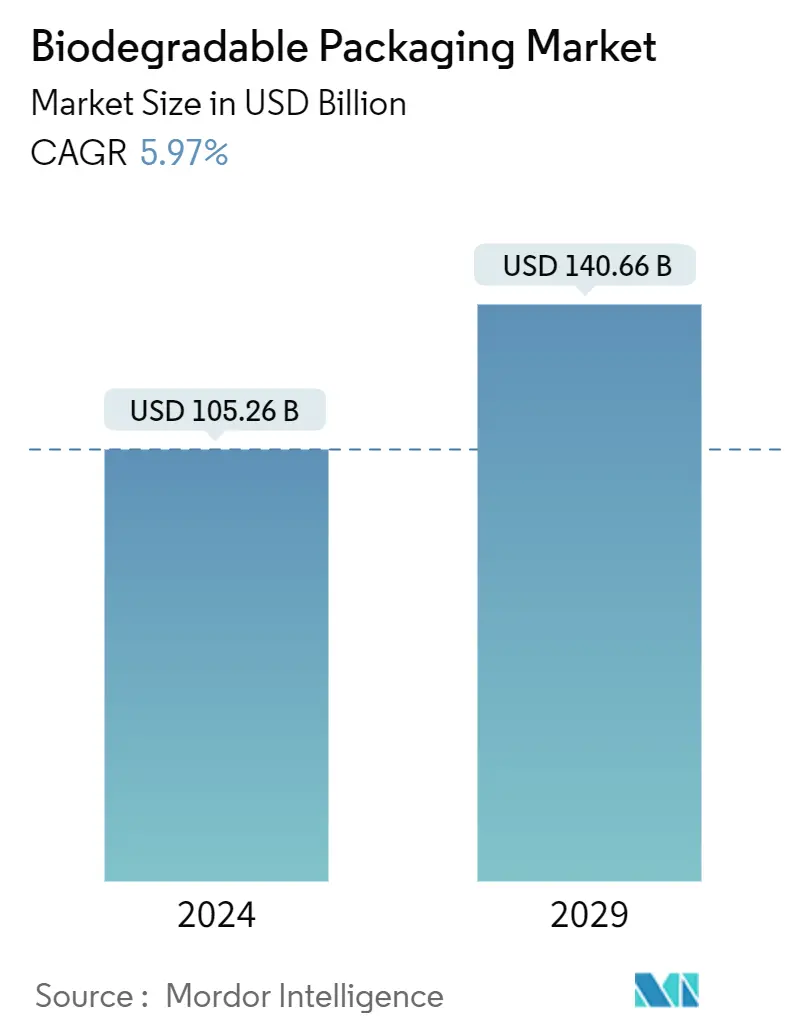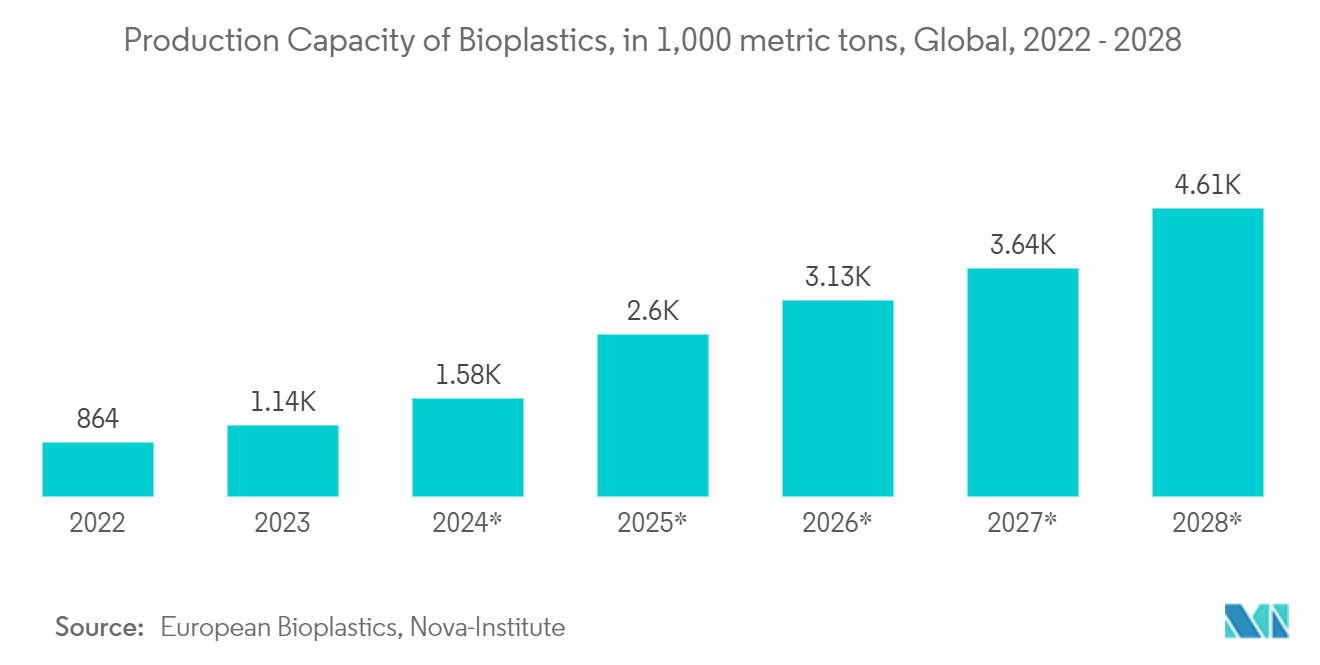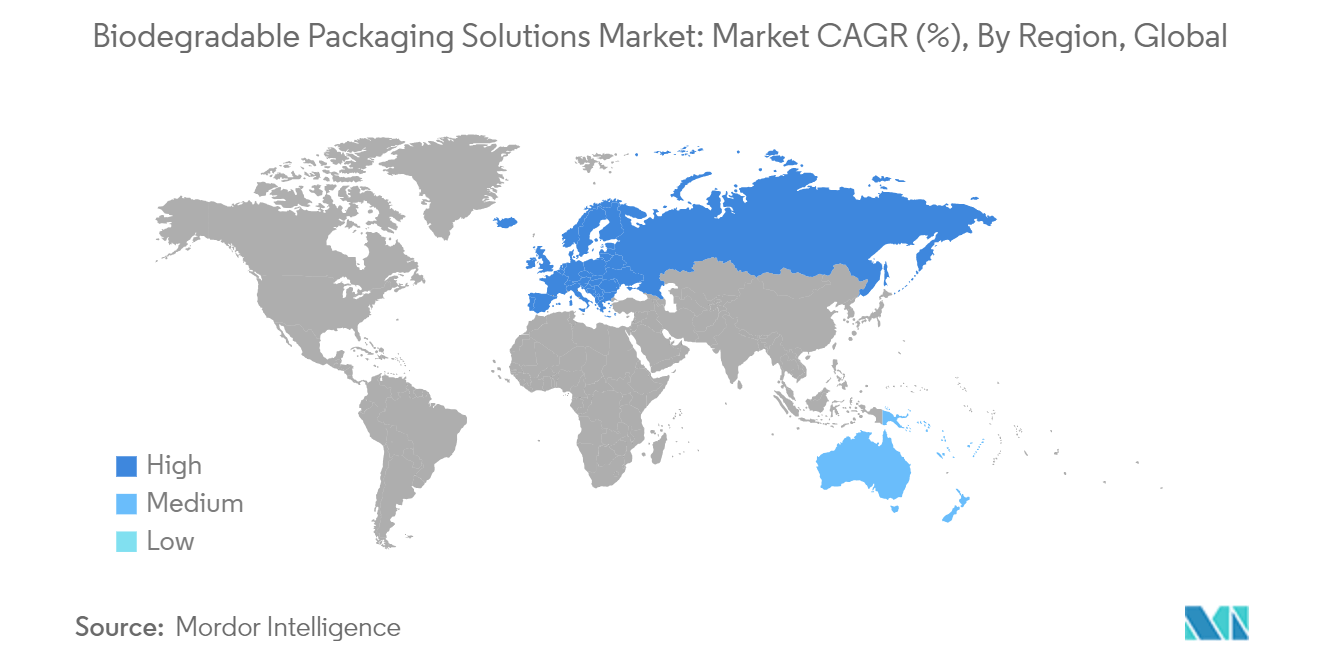Biodegradable Packaging Solutions Market Size

| Study Period | 2019 - 2029 |
| Market Size (2024) | USD 105.26 Billion |
| Market Size (2029) | USD 140.66 Billion |
| CAGR (2024 - 2029) | 5.97 % |
| Fastest Growing Market | Asia Pacific |
| Largest Market | Europe |
Major Players.webp)
*Disclaimer: Major Players sorted in no particular order |
Biodegradable Packaging Solutions Market Analysis
The Biodegradable Packaging Market size is estimated at USD 105.26 billion in 2024, and is expected to reach USD 140.66 billion by 2029, growing at a CAGR of 5.97% during the forecast period (2024-2029).
The market for biodegradable packaging solutions has grown over the past few years due to the growing awareness about environmental conservation, especially in the post-pandemic scenario. The market's growth is driven by the increase in consumer preference for sustainable packaging materials and the growing demand for recyclable and biodegradable products across various end-user industries.
- Biodegradable packaging solutions are the materials reprocessed from a recovered material using a manufacturing process and then included in a final product or component. Recycled material is any material that has already served the use that it was initially intended for and is being used for packaging. Recycled content is promoted as it significantly reduces organizational waste footprints while optimizing the manufacturing process. With recycled products, recycled content will improve a company's sustainability, and due to the efficiency of the process, it is also associated with increased cost benefits.
- Technological advancements are leading to the development of innovative recyclable packaging solutions. Manufacturers are focused on creating packaging materials that are environmentally friendly and offer the required protection and functionality for the products being packaged. As a result, the recycled packaging market is witnessing the introduction of new materials, designs, and manufacturing processes that cater to diverse needs.
- Various countries and organizations are avoiding the utilization of single-use plastic packaging, which is expected to create a favorable market scenario for biodegradable packaging. In countries like India, where packaging waste has become a major issue, state and central governments are taking steps to prohibit the use of single-use plastic.
- Biodegradable plastics break down naturally in the environment through microorganisms such as bacteria and fungi. This means that biodegradable plastics can be composted and returned to the environment, unlike conventional plastics, which do not decompose.
- The source material does not necessarily imply it can be broken down into the natural environment. For instance, biodegradable plastics might only break down in industrial composting plants, where they can be heated to a high enough temperature to allow microbes to break them down at a noticeable rate.
- According to Thermogard, biodegradable plastics require a particular environment to break down entirely. If left to do so in landfills or seas, biodegradable plastics break into tiny microplastics, impacting the environment. However, biodegradable plastics are more environmentally friendly than traditional plastics as they decompose faster in landfills.
Biodegradable Packaging Solutions Market Trends
Plastic is Expected to Hold a Significant Market Share
- Over the past decade, the demand for bioplastics has surged. This surge can be attributed to a heightened global emphasis on environmental conservation, a shift toward bio-based and natural resources in manufacturing, and the implementation of diverse regulations worldwide to promote sustainable resource utilization and waste management. With consumers increasingly favoring eco-friendly materials and a rising environmental consciousness, the market is poised for significant growth.
- The demand for bio-friendly plastics in the packaging industry is enormous and is expected to remain the same in the next five years. Biodegradable plastic packaging solutions are witnessing a rise in the industry owing to their low environmental impact, growing focus on recyclability and sustainability, and government focus on efficient packaging management.
- Bio-based materials have several potential benefits for greenhouse gas balances and other environmental impacts over life cycles. The use of biodegradable materials is expected to contribute to sustainability and a high reduction in the environmental effects associated with the disposal of oil-based polymers.
- Unlike its fossil fuel-based counterpart, biodegradable plastic packaging naturally decomposes in the environment through microorganisms, posing lesser risks. Industries, spanning from food & beverages to healthcare, are increasingly pivoting toward biodegradable packaging. Beyond environmental benefits, these plastics also promise cost reductions in production. Moreover, they open avenues for new markets, especially in products designed for composting.
- As per the European Bioplastics Nova-Institute, global production capacity for biodegradable plastics stood at 1,136 metric tons in 2023. This figure is expected to increase to 4,605 metric tons by 2028. This uptrend in production capacity is poised to fuel the demand for biodegradable plastics.

Asia-Pacific is Expected to Record Significant Growth
- Government initiatives and the development of environment-friendly packaging products are the main reasons for the growing demand in the market. Consumers are increasingly aware of the environmental risks caused by plastic waste, and the development of advanced technology has prompted many Indian manufacturers to create biodegradation packaging solutions.
- The food & beverage industry was the first adopter of biodegradable packaging, followed by personal care products and cosmetics in India. Significant innovation in packaging and labeling has occurred within the food packaging industry. The market for eco-friendly food packaging is divided into material choices, applications, types, and techniques.
- Plastic waste generation in India has grown every ten years. In 2021, it was 17.5 million metric tons, which is expected to increase to 31.40 million metric tons by 2031 and 55 million metric tons by 2041. With increasing plastic waste generation in India, this region provides opportunities for manufacturers to convert and recycle the waste plastic into bioplastic packaging.
- Japan’s packaging trends have changed a lot in recent years. One of the main reasons for this is the increased awareness about environmental issues. This has led to a focus on reducing container weight and streamlining packaging materials. This eco-friendly approach has resulted in products using recyclable materials. In addition, there is a strong focus on creating high-performing products that focus on safety and convenience.

Biodegradable Packaging Solutions Industry Overview
The biodegradable packaging solutions market is fragmented. Major market players include Amcor Limited, Sealed Air Corporation, Mondi Group PLC, and Tetra Pak International SA. Several regional firms in developing countries like India are also trying to gain market share. Barriers to entry are low, resulting in the advent of smaller players and further increasing competitive rivalry.
- June 2024: Bioelements Group, a sustainable packaging firm in Latin America, unveiled its strategic move into the US market. The company established its US headquarters in Houston and announced plans for a BIOLab research facility. Bioelements specializes in an advanced packaging range, leveraging biobased, biodegradable, and compostable materials crafted through science and technology. With this expansion, the company aims to align closely with the evolving packaging demands of US brands across retail, e-commerce, food, home, personal care, and specialty industries.
- February 2024: SEE, a global packaging solutions provider, underscored its commitment to sustainable packaging by unveiling a pioneering biobased industrial compostable tray for protein packaging. This tray, designed for modern food processing facilities, underwent rigorous testing. SEE's latest offering, the CRYOVAC overwrap, is crafted from a USDA-certified biobased resin, boasting a 54% biobased content derived from renewable wood cellulose.
Biodegradable Packaging Solutions Market Leaders
-
Mondi Group
-
Tetra Pak International SA
-
Sealed Air Corporation
-
International Paper Company
-
Amcor Group GmbH
*Disclaimer: Major Players sorted in no particular order
.webp)
Biodegradable Packaging Solutions Market News
- February 2024: TIPA introduced compostable packaging, boasting the same durability, shelf life, barrier properties, transparency, and clarity as traditional plastic. This packaging, certified biodegradable in both domestic and industrial compost settings, promises a plastic-free alternative. TIPA's lineup spans coffee capsules, zipper bags, mesh packaging, and resealable containers. The company also unveiled a line of fully compostable and recyclable rice straw containers.
- February 2024: Print & Pack debuted, aiming to cater to North America's small businesses and eco-conscious brands with sustainable packaging solutions. Its portfolio includes advanced technologies like BDP for biodegradable packaging, certified with GREENGUARD Gold, and solutions like INVISIBLEBAG, which is a compostable and water-soluble innovation.
Biodegradable Packaging Market Report - Table of Contents
1. INTRODUCTION
- 1.1 Study Assumptions & Market Definition
- 1.2 Scope of the Study
2. RESEARCH METHODOLOGY
3. EXECUTIVE SUMMARY
4. MARKET INSIGHTS
- 4.1 Market Overview
- 4.2 Industry Value Chain Analysis
-
4.3 Industry Attractiveness - Porter's Five Forces Analysis
- 4.3.1 Bargaining Power of Suppliers
- 4.3.2 Bargaining Power of Consumers
- 4.3.3 Threat of New Entrants
- 4.3.4 Threat of Substitute Products
- 4.3.5 Intensity of Competitive Rivalry
- 4.4 Technology Snapshot
5. MARKET DYNAMICS
-
5.1 Market Drivers
- 5.1.1 Increasing Demand For Sustainable Products By Consumers And Brands
- 5.1.2 Stringent Government Regulations
-
5.2 Market Restraints
- 5.2.1 Lack of Supply of Bio-plastics and Related Materials
6. MARKET SEGMENTATION
-
6.1 By Material Type
- 6.1.1 Plastic
- 6.1.1.1 Starch-Based Plastics
- 6.1.1.2 Cellulose-Based Plastics
- 6.1.1.3 Polylactic Acid (PLA)
- 6.1.1.4 Poly-3-Hydroxybutyrate (PHB)
- 6.1.1.5 Polyhydroxyalkanoates (PHA)
- 6.1.2 Paper
- 6.1.2.1 Kraft Paper
- 6.1.2.2 Flexible Paper
- 6.1.2.3 Corrugated Fiberboard
- 6.1.2.4 Boxboard
-
6.2 By Application
- 6.2.1 Food Packaging
- 6.2.2 Beverage Packaging
- 6.2.3 Pharmaceutical Packaging
- 6.2.4 Personal/Homecare Packaging
-
6.3 By Geography
- 6.3.1 North America
- 6.3.1.1 United States
- 6.3.1.2 Canada
- 6.3.2 Europe
- 6.3.2.1 United Kingdom
- 6.3.2.2 Germany
- 6.3.2.3 France
- 6.3.2.4 Rest of Europe
- 6.3.3 Asia-Pacific
- 6.3.3.1 China
- 6.3.3.2 India
- 6.3.3.3 Japan
- 6.3.3.4 Rest of Asia Pacific
- 6.4 Rest of the World
7. COMPETITIVE LANDSCAPE
-
7.1 Company Profiles
- 7.1.1 Tetra Pak International SA
- 7.1.2 Amcor Group Gmbh
- 7.1.3 Mondi Group
- 7.1.4 Sealed Air Corporation
- 7.1.5 Elevate Packaging Inc.
- 7.1.6 Kruger Inc.
- 7.1.7 Biopak PTY Ltd (Duni Group)
- 7.1.8 Smurfit Kappa Group PLC
- 7.1.9 Berkley International Packaging Limited
- 7.1.10 Greenpack Limited
- 7.1.11 International Paper Company
- 7.1.12 Ranpak Holding Corporation
- *List Not Exhaustive
8. INVESTMENT ANALYSIS
9. FUTURE OUTLOOK OF THE MARKET
** Subject To AvailablityBiodegradable Packaging Solutions Industry Segmentation
Biodegradability refers to the ability of materials to break down and return to nature. To qualify as biodegradable, packaging products or materials must completely break down and decompose into natural elements within a short time after disposal, typically in a year or less.
The biodegradable packaging solutions market is segmented by material type (plastic [starch-based plastics, cellulose-based plastics, polylactic acid (PLA), poly-3-hydroxybutyrate (PHB), polyhydroxyalkanoates (PHA), and others] and paper [kraft paper, flexible paper, corrugated fiberboard, boxboard, and others]), application (food & beverage, pharmaceutical, personal/homecare, and others), and geography (North America [the United States and Canada], Europe [the United Kingdom, Germany, France, and Rest of Europe], Asia-Pacific [China, India, Japan, and Rest of Asia-Pacific], and Rest of the World. The market sizes and forecasts are provided in terms of value (USD) for all the above-mentioned segments.
| By Material Type | Plastic | Starch-Based Plastics |
| Cellulose-Based Plastics | ||
| Polylactic Acid (PLA) | ||
| Poly-3-Hydroxybutyrate (PHB) | ||
| Polyhydroxyalkanoates (PHA) | ||
| By Material Type | Paper | Kraft Paper |
| Flexible Paper | ||
| Corrugated Fiberboard | ||
| Boxboard | ||
| By Application | Food Packaging | |
| Beverage Packaging | ||
| Pharmaceutical Packaging | ||
| Personal/Homecare Packaging | ||
| By Geography | North America | United States |
| Canada | ||
| By Geography | Europe | United Kingdom |
| Germany | ||
| France | ||
| Rest of Europe | ||
| By Geography | Asia-Pacific | China |
| India | ||
| Japan | ||
| Rest of Asia Pacific |
Biodegradable Packaging Market Research FAQs
How big is the Biodegradable Packaging Solutions Market?
The Biodegradable Packaging Solutions Market size is expected to reach USD 105.26 billion in 2024 and grow at a CAGR of 5.97% to reach USD 140.66 billion by 2029.
What is the current Biodegradable Packaging Solutions Market size?
In 2024, the Biodegradable Packaging Solutions Market size is expected to reach USD 105.26 billion.
Who are the key players in Biodegradable Packaging Solutions Market?
Mondi Group, Tetra Pak International SA, Sealed Air Corporation, International Paper Company and Amcor Group GmbH are the major companies operating in the Biodegradable Packaging Solutions Market.
Which is the fastest growing region in Biodegradable Packaging Solutions Market?
Asia Pacific is estimated to grow at the highest CAGR over the forecast period (2024-2029).
Which region has the biggest share in Biodegradable Packaging Solutions Market?
In 2024, the Europe accounts for the largest market share in Biodegradable Packaging Solutions Market.
What years does this Biodegradable Packaging Solutions Market cover, and what was the market size in 2023?
In 2023, the Biodegradable Packaging Solutions Market size was estimated at USD 98.98 billion. The report covers the Biodegradable Packaging Solutions Market historical market size for years: 2019, 2020, 2021, 2022 and 2023. The report also forecasts the Biodegradable Packaging Solutions Market size for years: 2024, 2025, 2026, 2027, 2028 and 2029.
What challenges does the Biodegradable Packaging Market face?
The key challenges faced by the Biodegradable Packaging Market include higher costs of biodegradable materials compared to conventional packaging and limited recycling facilities.
What are the key drivers of the Biodegradable Packaging Market?
Key factors driving the Biodegradable Packaging Market are: a) Increasing environmental concerns b) Stringent government regulations on plastic use c) Growing consumer preference for sustainable packaging
What challenges does the Biodegradable Packaging Market face?
The key challenges faced by the Biodegradable Packaging Market include higher costs of biodegradable materials compared to conventional packaging and limited recycling facilities.
Compostable Packaging Solutions Industry Report
The global biodegradable packaging market is witnessing significant growth, fueled by a surge in consumer preference for sustainable packaging and an increase in demand across various industries. This expansion is supported by government and non-government initiatives promoting eco-friendly packaging solutions, with a notable contribution from biodegradable packaging companies and suppliers. These entities are innovating and expanding their capacities, especially in biodegradable paper packaging, to meet the rising demand. The shift towards sustainable practices is driven by legislative changes, consumer awareness, and a desire to reduce environmental footprints, making biodegradable packaging a preferred choice. This trend is evident across industries, including food, beverage, personal care, and pharmaceuticals, as they move towards more sustainable packaging solutions. Compostable Packaging Solutions market analysis by Mordor Intelligence™ highlights this growth, offering insights into market share, size, and revenue growth rates. For a deeper understanding, a free report PDF download is available, providing a forecast outlook and historical overview of the market. As the market evolves, biodegradable packaging suppliers are crucial in the transition towards sustainability, reflecting changing consumer preferences and regulatory pressures.



